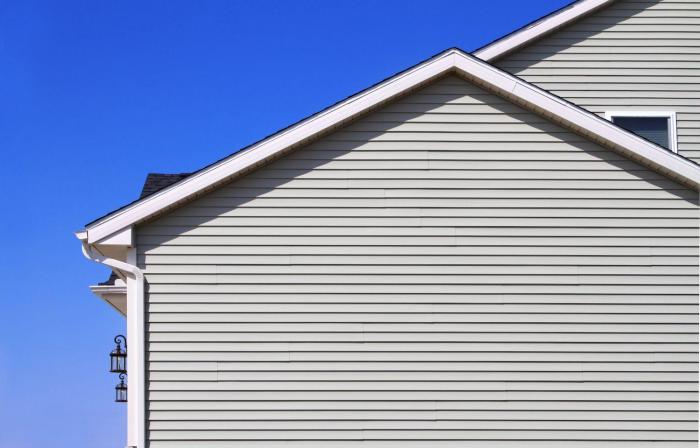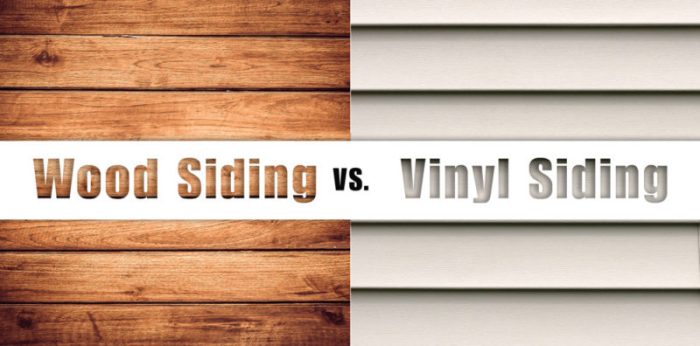Exploring the differences between wood siding and vinyl siding sheds light on the pros and cons of each material, guiding homeowners towards the best choice for their needs. From aesthetics to environmental impact, this comparison covers all aspects to help you make an informed decision.
As we delve deeper into the characteristics and benefits of wood siding versus vinyl siding, you'll gain valuable insights into these popular options for home exteriors.
Wood Siding
Wood siding is a classic choice for homes that offers a natural and timeless look. It is made from various types of wood, each with its own unique characteristics and benefits.Wood siding offers several advantages for homeowners. It is biodegradable, renewable, and has a high aesthetic appeal, adding warmth and character to any house.
Wood is also a good insulator, helping to regulate indoor temperatures and reduce energy costs.
Types of Wood for Siding
- Cedar: Known for its natural resistance to decay and insects, cedar is a popular choice for wood siding. It has a rich color and can be left untreated for a natural weathered look.
- Pine: Pine is a more affordable option for wood siding. It is lightweight and easy to work with, but it requires more maintenance to prevent rot and insect damage.
- Redwood: Redwood is a durable and long-lasting wood option for siding. It has natural oils that make it resistant to decay and insects, but it comes at a higher cost.
Maintenance for Wood Siding
Wood siding requires regular maintenance to keep it looking its best and protect it from the elements. This includes painting or staining every few years to prevent rot, warping, and insect infestations. Cleaning the siding regularly and inspecting for any damage is also important to ensure its longevity.
Vinyl Siding
Vinyl siding is a popular choice for homeowners looking for a low-maintenance and cost-effective alternative to wood siding. It is made from polyvinyl chloride (PVC) resin and comes in a variety of colors and styles to suit different aesthetic preferences.
Features of Vinyl Siding
- Water-resistant: Vinyl siding is highly resistant to water, making it a great option for areas with high humidity or frequent rain.
- Low maintenance: Unlike wood siding, vinyl siding does not require regular painting or staining, saving homeowners time and money on upkeep.
- Durable: Vinyl siding is known for its durability and ability to withstand harsh weather conditions, such as strong winds and heavy rain.
- Color options: With a wide range of colors available, homeowners can choose a vinyl siding that complements their home's exterior design.
Advantages of Choosing Vinyl Siding
- Cost-effective: Vinyl siding is generally more affordable than wood siding, both in terms of material costs and installation.
- Low maintenance: As mentioned earlier, vinyl siding requires minimal upkeep, saving homeowners time and money in the long run.
- Energy-efficient: Some vinyl siding options come with insulation properties, helping to improve the energy efficiency of a home.
- Longevity: Vinyl siding has a long lifespan, often lasting 20-30 years or more with proper care.
Cost of Vinyl Siding Installation vs Wood Siding
- On average, vinyl siding installation costs less than wood siding due to the lower cost of materials and easier installation process.
- While the exact cost can vary based on factors like the size of the home and labor costs, vinyl siding is generally a more budget-friendly option.
Durability and Longevity of Vinyl Siding
- Vinyl siding is resistant to rot, insect damage, and moisture, making it a durable choice for homeowners looking for a long-lasting siding option.
- With proper maintenance, vinyl siding can maintain its appearance and structural integrity for decades, providing a reliable and low-maintenance exterior for a home.
Aesthetics
When it comes to the aesthetics of siding, both wood and vinyl offer unique visual appeal that can greatly impact the overall look of a house. Let's delve into the key differences in appearance between wood siding and vinyl siding, as well as explore the various styles, finishes, and color options available for each.
Contrast in Appearance
Wood siding exudes a natural and timeless charm, with its rich texture and warm tones that can enhance the traditional or rustic appearance of a home. On the other hand, vinyl siding offers a more uniform and sleek look, providing a modern and low-maintenance alternative to wood.
Styles and Finishes
Wood siding comes in a variety of styles such as clapboard, shakes, and shingles, each offering a distinct look to suit different architectural designs. It can also be stained or painted in numerous finishes to achieve a customized appearance. In contrast, vinyl siding is available in styles like horizontal panels, vertical panels, and scallops, with finishes that mimic the look of wood or offer vibrant colors for a more contemporary aesthetic.
Complementing Architectural Styles
Wood siding is often preferred for traditional, colonial, or craftsman-style homes, as it complements their classic architectural elements. Vinyl siding, on the other hand, is commonly used in modern or minimalist designs where a clean and uniform look is desired.
Both types of siding can be adapted to various architectural styles depending on the desired aesthetic.
Impact of Color Options
The color options for siding play a crucial role in defining the overall look of a house. Wood siding can be painted in a wide range of hues to match the existing color scheme or create a striking contrast. Vinyl siding offers an extensive selection of colors that are fade-resistant and require minimal upkeep, allowing homeowners to experiment with bold or subtle tones to achieve the desired curb appeal.
Environmental Impact

Wood siding and vinyl siding have different environmental impacts when it comes to eco-friendliness, sustainability, recyclability, and manufacturing and disposal concerns.
Eco-Friendliness of Wood Siding vs Vinyl Siding
Wood siding is considered more eco-friendly compared to vinyl siding because it is a natural material that is renewable and biodegradable. Wood siding also has a lower carbon footprint during production and emits fewer greenhouse gases. In contrast, vinyl siding is a synthetic material made from PVC, which is derived from fossil fuels and has a higher environmental impact in terms of resource depletion and pollution.
Sustainability of Using Wood Siding in Construction
Wood siding is a sustainable choice for construction as it is sourced from responsibly managed forests or reclaimed wood, reducing the environmental impact of deforestation. By using wood siding, builders can support sustainable forestry practices and promote biodiversity in forest ecosystems.
Recyclability of Vinyl Siding
Vinyl siding is recyclable to some extent, but the process can be challenging and costly. While some vinyl siding can be recycled into new products, a significant amount still ends up in landfills, contributing to plastic pollution and environmental degradation.
Environmental Concerns with Manufacturing and Disposing of Both Siding Materials
The manufacturing of wood siding typically involves less energy and chemicals compared to vinyl siding production. However, the use of chemical treatments and finishes in wood siding can raise concerns about indoor air quality and environmental pollution. On the other hand, the manufacturing of vinyl siding releases toxic chemicals into the environment and poses risks to human health and ecosystems.
Disposing of both siding materials can also be problematic, as improper disposal can lead to pollution of soil, water, and air.
End of Discussion

In conclusion, understanding the key differences between wood siding and vinyl siding empowers homeowners to make a decision that aligns with their preferences and budget. Whether you prioritize aesthetics, durability, or sustainability, this comparison equips you with the knowledge needed to enhance your home's exterior with confidence.
Questions Often Asked
Is wood siding more expensive than vinyl siding?
While wood siding typically has a higher upfront cost than vinyl siding, it can add significant value to a home and may require less maintenance over time.
Which type of siding is more environmentally friendly: wood or vinyl?
Wood siding is generally considered more eco-friendly as it's a renewable resource, whereas vinyl siding is a plastic material that raises concerns about its environmental impact during production and disposal.
Can vinyl siding mimic the look of real wood effectively?
Advancements in vinyl siding technology have made it possible for vinyl siding to closely resemble the appearance of real wood, offering homeowners a low-maintenance alternative with a similar aesthetic.
How often should wood siding be repainted or refinished?
The frequency of repainting or refinishing wood siding depends on factors like climate and quality of the initial finish. On average, wood siding may need to be repainted every 5-10 years to maintain its appearance and protection.
Does vinyl siding crack or fade over time?
Vinyl siding is known for its durability and resistance to cracking and fading, making it a low-maintenance option that retains its color and shape over many years.








